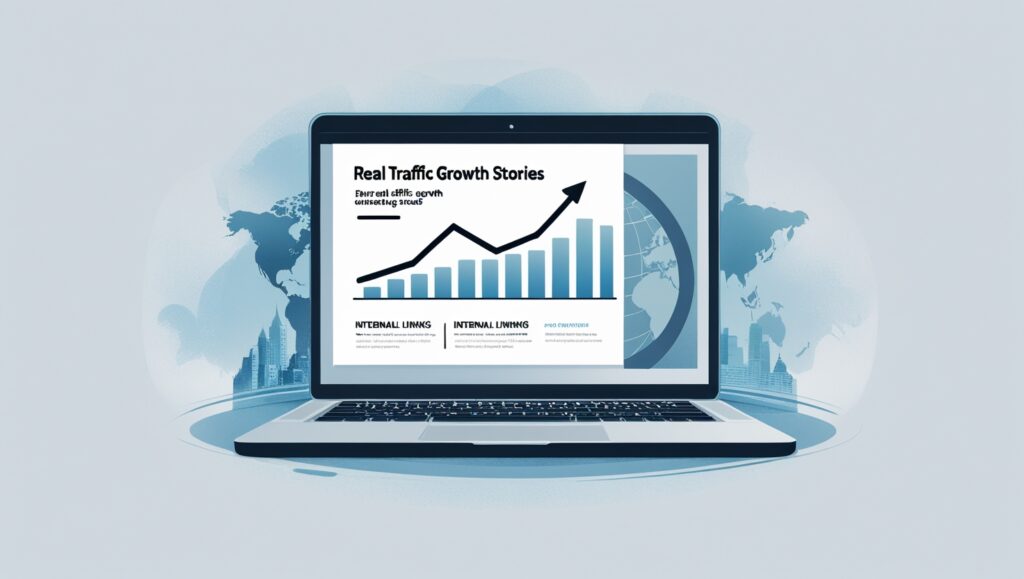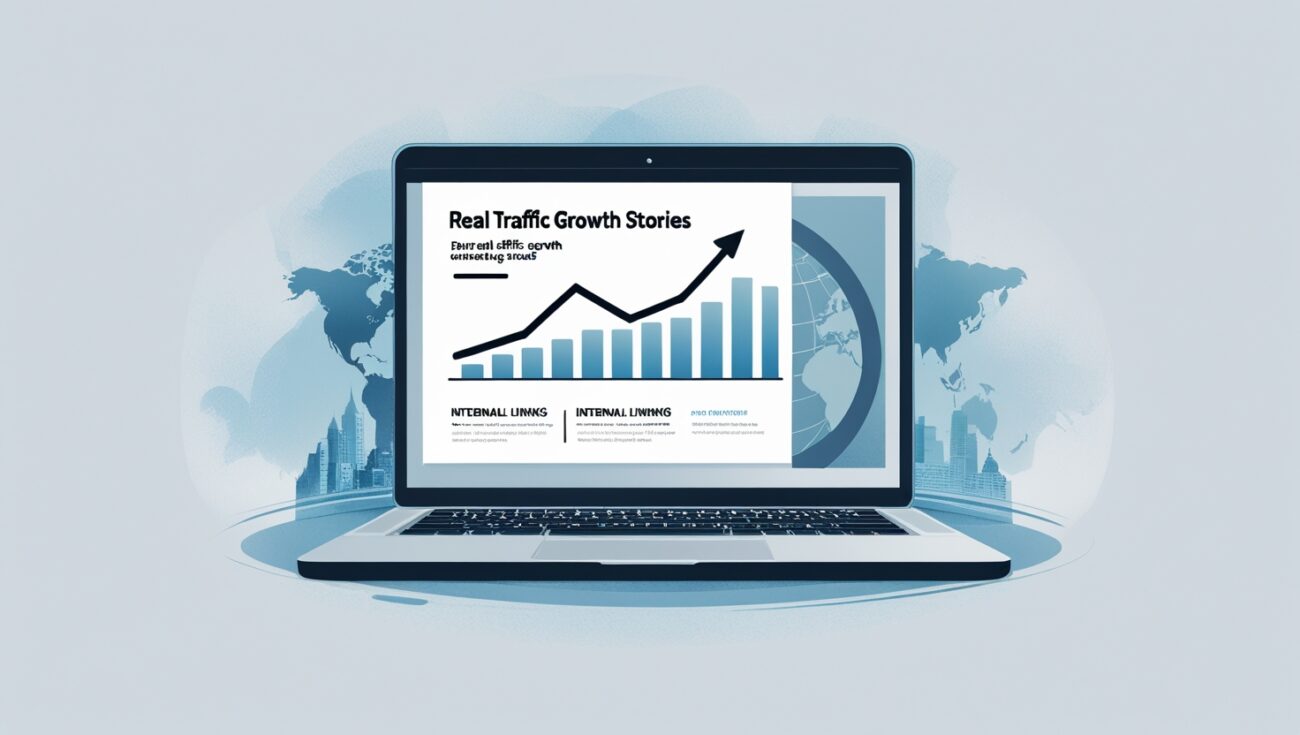Internal Linking Case Studies: Real Traffic Growth Stories
In the world of SEO, we hear a lot of talk about theory. We’re told that internal links are important, that they pass link equity, and that they help with rankings. But as a business owner, I’ve always wanted to see real, tangible proof. I wanted to see how a simple change could lead to a measurable increase in traffic. It wasn’t until I started treating my website as a series of interconnected experiments that I truly understood the power of a strategic internal linking strategy.
These aren’t just abstract ideas; they are real-world case studies from my own sites and from sites I’ve analyzed. They are stories of how a few small, intentional changes can lead to significant traffic growth and ranking improvements. If you’ve ever wondered whether internal links actually matter, these stories are for you.

Table of Contents
Case Study 1: The “Orphaned Page” Rescue Mission
I once had a blog post that was a comprehensive guide to a very niche topic. I had spent hours researching and writing it, but it was getting almost no traffic. When I ran a site audit, I discovered it was an orphaned page—it had no internal links pointing to it from any other article. It was essentially invisible to Google’s crawlers. My fix was simple: I went back to three of my highest-traffic, most authoritative blog posts and added a contextual internal link to the struggling guide. Within a few weeks, that orphaned page went from a few visits a day to over 100, and it started ranking on the first page of Google for its target keywords. A tool like Linkbot can easily find your orphaned pages so you can rescue them and send their rankings soaring.
Case Study 2: The “Topical Cluster” Authority Boost
I had a series of articles on a single topic that were all ranking on the second or third page of Google. They were good articles, but they weren’t getting the traffic they deserved. I realized they were competing with each other for rankings. My solution was to create a comprehensive pillar page that covered the main topic, and then I linked every single one of the related articles to the new pillar page. I also made sure the pillar page linked out to all the supporting articles. This created a clear “topical cluster,” and within a month, the entire group of articles saw a collective traffic increase of over 30%. The pillar page itself started ranking on the first page, and the supporting articles followed.
Case Study 3: The “Broken Link” Authority Recovery
I was running a regular site audit when I discovered a broken internal link on one of my oldest and most authoritative articles. It was a link to a resource that I had long since deleted. That broken link was essentially a hole in my site, wasting valuable link equity. My fix was to remove the broken link and replace it with a new, updated link to a highly relevant page that was struggling to rank. Within a few weeks, the new destination page saw a measurable increase in rankings and organic traffic. By simply fixing a hole in my site, I was able to redirect trapped authority and give a struggling page a much-needed SEO boost. With a tool like Linkbot, you can easily find and fix all of your broken internal links.
The Takeaway: From Theory to Reality
These case studies have a common theme: internal linking isn’t just a technical concept. It’s a powerful, tangible strategy for unlocking your website’s hidden potential. Each of these stories proves that a small, intentional change can lead to significant and measurable traffic growth. The secret is knowing what to fix and how to fix it efficiently.
The Common Denominator: A Helping Hand
The one thing all these success stories have in common is that the fixes were made possible by a systematic approach. Manually finding orphaned pages, analyzing topical clusters, and auditing for broken links is incredibly time-consuming, especially for a large website. Automated internal linking software is the key that makes these repeatable strategies accessible to everyone. If you want to start creating your own internal linking success stories, I highly recommend exploring how Linkbot can help you.
Conclusion: Start Your Own Success Story
These are just a few examples of the real-world results that a strategic internal linking plan can deliver. By building a clear, organized, and intentional network of links, you can take control of your SEO and drive real, tangible traffic growth. Don’t let your website’s potential go to waste. Start applying these strategies today and get ready to see your own traffic growth story unfold.
My journey taught me that a major mistake is seeing SEO as a series of individual battles. By implementing a systematic internal linking strategy, I learned to view my website as a team. I saw how my highest-ranking pages could pass authority to my lower-ranking pages, and how every page could work together to build a more powerful, cohesive unit. This mental shift was a game-changer.
The long-term, compounding effect of these specific strategies is what makes them so powerful. Each time you add a thoughtful, relevant link, you are not just performing a task; you are building your website’s authority, one link at a time. These small, consistent improvements add up to a significant competitive advantage over the long term, making your website an increasingly powerful asset.
I can say from personal experience that there is a special kind of satisfaction that comes from seeing a direct correlation between a fix and a ranking boost. It’s the feeling of taking a tangled mess and organizing it into a clean, logical network. The result is a website that just feels better to navigate, for both users and the people managing it.
A clean internal link structure also has a huge impact on your website’s overall trustworthiness and authority. When a user or a search engine bot lands on your page and sees a clear network of interconnected, relevant articles, it signals that you are a serious, comprehensive resource on the topic. This kind of professional organization is exactly what Google looks for.
The most important part of this foundational skill is building a consistent habit of linking. It’s not about a single audit and then forgetting about it. A good website is a living thing, and it needs regular maintenance to ensure your internal links stay clean, which is a key part of long-term SEO success.
I felt like I was finally in the driver’s seat of my SEO. For years, I had relied on external factors, which felt like I was giving up control of my SEO destiny. But by mastering a simple task like auditing and fixing my internal links, I was proactively building my site’s authority from the inside out, on my own terms, which was an empowering and exciting feeling.
By implementing a strategy that serves both SEO and conversions, you are also directly addressing Google’s E-E-A-T framework. You are demonstrating expertise by creating topical clusters, you are showing authority by linking from strong pages, and you are providing a better user experience, which is a key part of what Google looks for in a trustworthy website.
I’ll never forget the first time I applied my new internal link strategy to a low-traffic, informational page that I thought was worthless. After I added a few strategic links from some of my top-performing articles, that low-traffic page started to get more organic traffic and even began to generate revenue through affiliate commissions.
One of the greatest benefits I got from using an automated tool to manage my link profile was the “to-do” list it provided. Instead of being overwhelmed by the sheer size of my website, the tool gave me a prioritized, actionable list of fixes to make. It transformed a monumental, frustrating task into a series of manageable steps that I could tackle in just minutes.
It’s crucial to understand the difference between a simple, generic link and a link that’s part of a strategic, mapped plan. A simple link is a one-off connection. A link that’s part of a plan is a purposeful part of a larger network, designed to pass authority and guide a user. The latter is far more powerful.
Ultimately, internal linking isn’t just a theory; it’s a powerful, tangible strategy for unlocking your website’s hidden potential. It’s a low-cost, high-impact fix that can instantly improve your site’s health and SEO performance. It’s the kind of foundational SEO work that every website owner should prioritize.
My final piece of advice is to not be intimidated. Start with a single case study, implement the strategy, and watch your own success story unfold. You will be amazed at the progress you make and the results you can achieve with a little bit of consistency and a clear plan.

